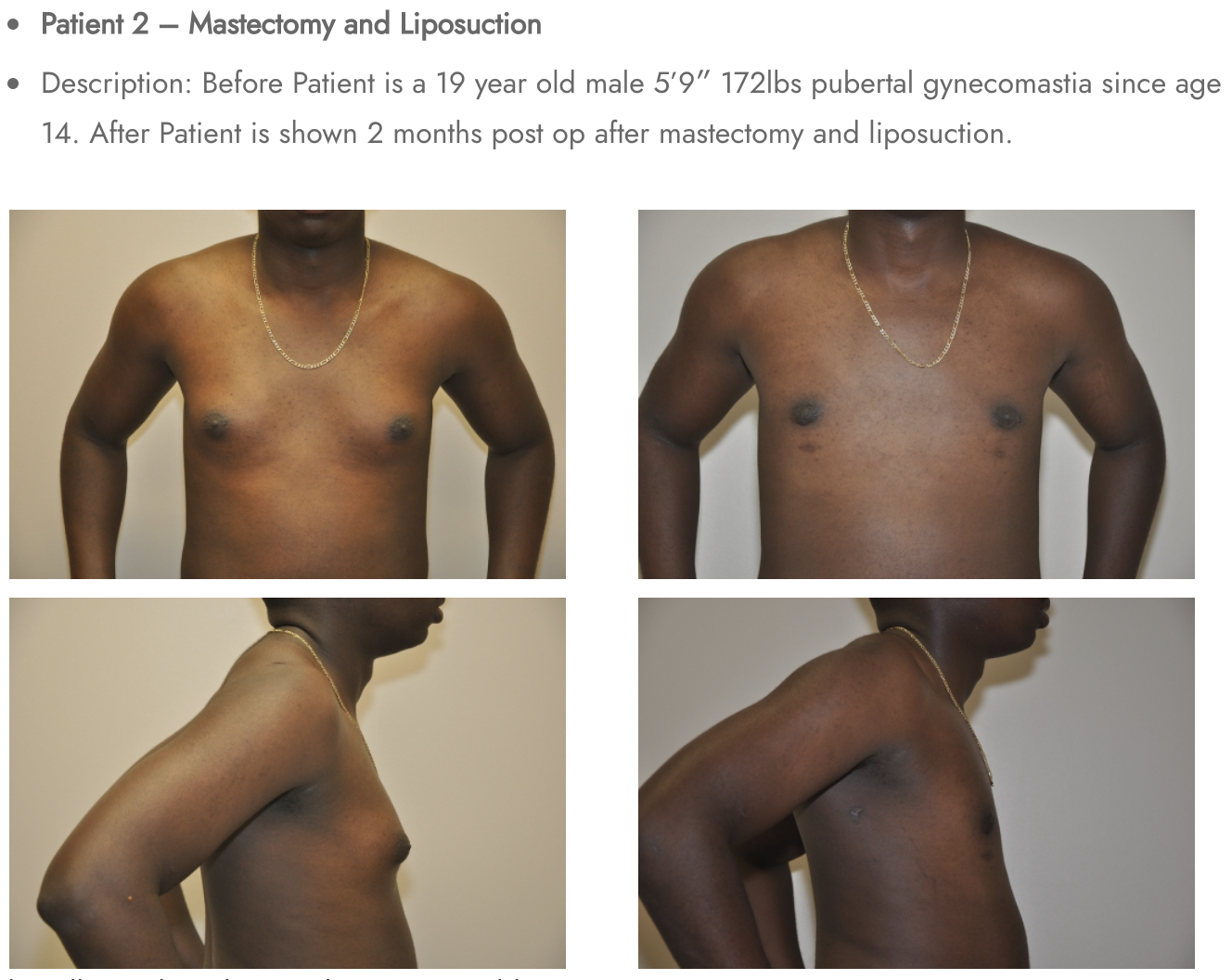Male Breast Reduction
You may not realize it, but gynecomastia — unwanted male breast tissue — is very common.
The condition is thought to affect 40 to 60 percent of men and occurs when hormones cause excessive breast tissue to develop during puberty. This excess tissue can develop on one or both sides of the chest.
Gynecomastia affects 60 to 90 percent of children, 50 to 60 percent of teens and 70 percent of men over 50.
In most cases, this unwanted breast tissue resolves over time, but not always. When it doesn’t, male breasts, also known as man boobs or “moobs,” can stick around until adulthood.
Dr. Jack Peterson is a dual-board-certified plastic surgeon who offers male patients a way to remove their unwanted breast tissue with male breast-reduction surgery.
Causes of Gynecomastia
In most cases, unwanted male breast tissue develops due to hormonal fluctuations during adolescence, primarily due to an imbalance of estrogen and testosterone (yes, men have estrogen, too!).
Other reasons for gynecomastia include:
- Hormone supplements
- Anabolic steroid use
- Recreational drugs, including marijuana, heroin and alcohol
- Some medications, including those used to treat prostate cancer, anxiety, heart disease and ulcers
- Certain medical conditions
- Genetics
- Medical conditions, including liver disease, hyperthyroidism, obesity and kidney disease
Why Treat Unwanted Male Breast Tissue?
Gynecomastia can make many men feel self-conscious about their appearance and negatively impact their self-esteem, day-to-day lives, activities and relationships.
Some men living with unwanted male breast tissue avoid situations where they’d be shirtless, like a pool or with an intimate partner, or avoid the gym locker room out of embarrassment.
Some men layer their clothing to make their unwanted male breast tissue less noticeable.
Hiding your body, avoiding social situations and shying away from intimacy because of your male breasts is no way to live. For many men, male breast-reduction surgery can greatly improve both their appearance and overall confidence.
Male Breast-Reduction Surgery
Male breast-reduction surgery to correct gynecomastia is ideal for men who are in good overall health and have realistic expectations of their treatment.
Men of any age can benefit from the procedure; however, we recommend waiting until puberty is complete for teens to see if gynecomastia resolves naturally.
In most cases, gynecomastia’s surgical correction is permanent, but unwanted breast tissue growth may happen again if hormones become unbalanced, significant weight gain occurs, or other contributing factors persist.
Male breast reduction is a safe and effective surgery for reducing unwanted breast tissue in men. It re-contours the chest, giving it a more masculine appearance.
How Is the Male Breast Reduction Surgery Performed?
Surgery to remove the unwanted male breast tissue involves the excision of excess tissue through a small incision near the areola combined with liposuction. If your male breasts are very large, you may also need an additional procedure to remove stretched-out, sagging skin.
In some cases, liposuction alone can remove fat and tissue, contributing to a more masculine chest appearance.
The procedure is performed under general anesthesia and is an outpatient procedure. In most cases, the surgery takes between one and two hours to complete, but this varies from patient to patient depending on the amount of tissue to be removed.
Before and After Male Breast Reduction
Before your male breast reduction, you will have a consultation with Dr. Peterson to determine if you are the right candidate for the procedure. At this time, Dr. Peterson will perform a physical exam of your breasts to determine that you do have gynecomastia and rule out the chance of male breast cancer.
Before your gynecomastia procedure, you should stop smoking for at least four weeks as well.
Preparing for surgery involves making sure that you stop medications that increase bleeding risk, quit smoking and talk to Dr. Peterson about any underlying health conditions you may have. Sharing this information can help minimize post-surgery complications and ensure great-looking results.
After your male breast reduction, you may need to wear a compression vest or garment to help reduce swelling, control pain and maximize your results.
You should expect some bruising and swelling after your gynecomastia surgery. Pain can be managed with over-the-counter medications or pain medications prescribed by Dr. Peterson.
Bruising and swelling typically resolves within a few weeks of the surgery. The final results of the procedure will be seen at about the six-month mark after your procedure.
Most men return to work and light activity within two weeks of their procedure. However, you should avoid lifting weights and strenuous activity for at least six weeks after your gynecomastia surgery. Dr. Peterson will go over your recovery during your consultation and give you your timeline for phasing activity back into your routine during the checkups after your procedure.
Dr. Peterson offers men a full array of plastic surgery and aesthetic services, including liposuction, body-lift procedures, abdominoplasty (tummy tuck), laser hair removal, as well as Botox and other injectables.
Learn about our offerings and schedule a consultation now to discuss male breast reduction for gynecomastia.













